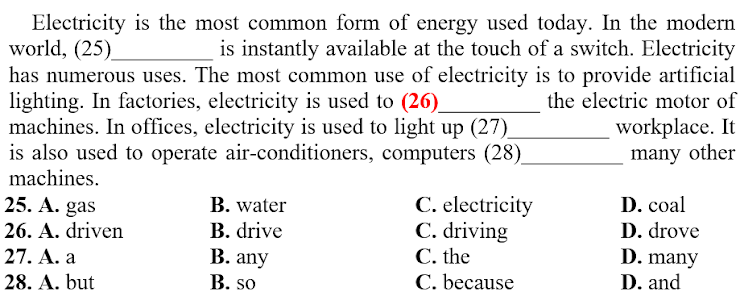Read the following passage and mark the letter A, B, C or D on your answer sheet to indicate the correct word or phrase that best fits each of the numbered blanks.
THE HISTORY OF WRITING
The development of writing (30) _______ a huge difference to the world and might see it as the beginning of the media. Pieces of pottery with marks on that are probably numbers have been discovered in China (31) _______ date from around 4000 BC. Hieroglyphics and other forms of "picture writing" developed in the area around Mesopotamia (modern-day Iraq), where the ancient Sumerian civilization was based, from around 3300 BC onwards. However, the first (32) _______ alphabet was used by the Phoenicians around 1050 BC. Their alphabet had 22 letters and it is estimated that it lasted for 1000 years. The first two signs were called "aleph" and "beth", which in Greek became "alpha" and "beta", which gave us the modern word "alphabet".
The modern European alphabet is based on the Greek and spread (33) _______ other European countries under the Romans. A number of changes took place as time passed. The Romans added the letter G, and the letter J and V were unknown to people in Shakespeare's time.
If we (34) _______ the history of punctuation, we also find some interesting facts. The Romans used to write quaesto at the end of a sentence in order to show that it was a Question. They started to write Qo in place of the whole word, and then put the Q above the o. In the end, that became the question mark "?"
Điền vào ô trống 32
A. true
B. accurate
C. exact
D. precise


Đáp án A.
Tạm dịch: However, the first _______ alphabet was used by the Phoenicians around 1050 BC: Tuy nhiên, bảng chữ cái _______ đầu tiên được sử dụng bởi những người xứ Phoenici khoảng năm 1050 TCN.
A. true (adj): chân thực, đúng với sự thật (thường dùng với một sự kiện, sự việc)
B. accurate (adj): chính xác, xác đáng (theo kiểu đúng với mọi chi tiết)
C. exact (adj): đúng đắn, chính xác (đưa ra tất cả các chi tiết một cách đúng đắn)
D. precise (adj): rõ ràng, chính xác, tỉ mỉ, nghiêm ngặt (đưa ra các chi tiết một cách rõ ràng, chính xác và thường dùng trong đo lường)